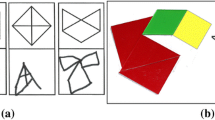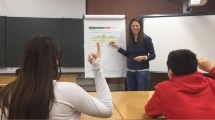Abstract
Drawing strategies are widely used as a powerful tool for promoting students’ learning and problem solving. In this article, we report the results of an inferential mediation analysis that was applied to investigate the roles that strategic knowledge about drawing and the accuracy of different types of drawings play in mathematical modelling performance. Sixty-one students were asked to create a drawing of the situation described in a task (situational drawing) and a drawing of the mathematical model described in the task (mathematical drawing) before solving modelling problems. A path analysis showed that strategic knowledge about drawing was positively related to students’ modelling performance. This relation was mediated by the type and accuracy of the drawings that were generated. The accuracy of situational drawing was related only indirectly to performance. The accuracy of mathematical drawings, however, was strongly related to students’ performance. We complemented the quantitative approach with a qualitative in-depth analysis of students’ drawings in order to explain the relations found in our study. Implications for teaching practices and future research are discussed.








Similar content being viewed by others
References
Arcavi, A. (2003). The role of visual representations in learning mathematics. Educational Studies in Mathematics, 52, 215–241.
Blum, W. (2011). Can modelling be taught and learnt? Some answers from empirical research. In G. Kaiser, W. Blum, R. Borromeo Ferri, & G. Stillman (Eds.), Trends in the teaching and learning of mathematical modelling - Proceedings of ICTMA14 (pp. 15–30). New York: Springer.
Blum, W., & Leiss, D. (2007). How do students and teachers deal with mathematical modelling problems? The example sugarloaf and the DISUM project. In C. Haines, P. L. Galbraith, W. Blum, & S. Khan (Eds.), Mathematical modelling (ICTMA 12): Education, engineering and economics (pp. 222–231). Chichester: Horwood.
Booth, R. D., & Thomas, M. O. (1999). Visualization in mathematics learning: Arithmetic problem-solving and student difficulties. The Journal of Mathematical Behavior, 18(2), 169–190.
Borromeo Ferri, R. (2006). Theoretical and empirical differentiations of the phases in the modelling process. ZDM–The International Journal on Mathematics Education, 38(2), 86–95.
Borromeo Ferri, R. (2007). Individual modelling routes of pupils – Analysis of modelling problems in mathematical lessons from a cognitive perspective. In C. Haines (Ed.), Mathematical modelling (ICTMA 12): Education, engineering and economics (pp. 260–270). Chichester: Horwood.
Bryant, F. B., & Satorra, A. (2012). Principles and practice of scaled difference chi-square testing. Structural Equation Modeling: A Multidisciplinary Journal, 19(3), 372–398.
Cox, R. (1999). Representation construction, externalised cognition and individual differences. Learning and Instruction, 9(4), 343–363.
Csíkos, C., Szitányi, J., & Kelemen, R. (2012). The effects of using drawings in developing young children’s mathematical word problem solving: A design experiment with third-grade Hungarian students. Educational Studies in Mathematics, 81(1), 47–65.
De Bock, D., Verschaffel, L., Janssens, D., Van Dooren, W., & Claes, K. (2003). Do realistic contexts and graphical representations always have a beneficial impact on students’ performance? Negative evidence from a study on modeling non-linear geometry problems. Learning and Instruction, 13(4), 441–463.
De Bock, D., Verschaffel, L., & Janssens, D. (1998). The predominance of the linear model in secondary school students’ solutions of word problems involving length and area of similar plane figures. Educational Studies in Mathematics, 35(1), 65–83.
Diezmann, C. M. (2005). Assessing primary students’ knowledge of networks, hierarchies and matrices using scenario-based tasks. In P. Clarkson, A. Downton, D. Gronn, M. Horne, A. McDonagh, R. Pierce, et al. (Eds.), Proceedings 28th annual conference of the mathematics education research group of Australasia (pp. 289–296). Sydney: MERGA.
Dubinsky, E. (1991). Reflective abstraction in advanced mathematical thinking. In D. O. Tall (Ed.), Advanced mathematical thinking (pp. 95–123). Dordrecht: Kluwer.
Dufour-Janvier, B., Bednarz, N., & Belanger, M. (1987). Pedagogical considerations concerning the problem of representation. In C. Janvier (Ed.), Problems of representation in the teaching and learning of mathematics (pp. 110–120). Hillsdale, NJ: Erlbaum.
Flavell, J. H. (1979). Metacognition and cognitive monitoring: A new area of cognitive developmental inquiry. American Psychologist, 34, 906–911.
Galbraith, P. L., & Stillman, G. (2006). A framework for identifying student blockages during transitions in the modelling process. ZDM–The International Journal on Mathematics Education, 38(2), 143–162.
Hegarty, M., & Kozhevnikov, M. (1999). Types of visual–spatial representations and mathematical problem solving. Journal of Educational Psychology, 91(4), 684.
Hembree, R. (1992). Experiments and relational studies in problem solving: A meta-analysis. Journal for Research in Mathematics Education, 23(3), 242–273.
Hu, L., & Bentler, P. M. (1999). Cutoff criteria for fit indexes in covariance structure analysis: Conventional criteria versus new alternatives. Structural Equation Modeling, 6(1), 1–55.
Kline, R. B. (2005). Principles and practice of structural equation modeling. New York, NY: Guilford Press.
Krug, A., & Schukajlow, S. (2013). Problems with and without connection to reality and students’ task-specific interest. In A. M. Lindmeier & A. Heinze (Eds.), Proceedings of the 37th conference of the international group for the psychology of mathematics education (Vol. 3, pp. 209–216). Kiel, Germany: PME.
Larkin, J. H., & Simon, H. A. (1987). Why a diagram is (sometimes) worth ten thousand words. Cognitive Science, 11, 65–99.
Leiss, D., Schukajlow, S., Messner, R., & Pekrun, R. (2010). The role of the situation model in mathematical modelling – Task analyses, student competencies, and teacher interventions. Journal für Mathematik-Didaktik, 31(1), 119–141.
Leutner, D., Leopold, C., & Sumfleth, E. (2009). Cognitive load and science text comprehension: Effects of drawing and mentally imagining text content. Computers in Human Behavior, 25(2), 284–289.
Lingel, K., Neuenhaus, N., Artelt, C., & Schneider, W. (2014). Der Einfluss des metakognitiven Wissens auf die Entwicklung der Mathematikleistung am Beginn der Sekundarstufe I [The influence of metacognitive knowledge on the development of mathematics achievement at the beginning of secondary school]. Journal für Mathematik-Didaktik, 35(1), 49–77.
Lucangeli, D., & Cornoldi, C. (1997). Mathematics and metacognition: What is the nature of the relationship? Mathematical Cognition, 3, 121–139.
Muthén, L. K., & Muthén, B. O. (1998–2012). Mplus user’s guide (7th ed.). Los Angeles: Muthén & Muthén.
Niss, M., Blum, W., & Galbraith, P. L. (2007). Introduction. In W. Blum, P. L. Galbraith, H.-W. Henn, & M. Niss (Eds.), Modelling and applications in mathematics education: The 14th ICMI study (pp. 1–32). New York: Springer.
Preacher, K. J., & Hayes, A. F. (2008). Asymptotic and resampling strategies for assessing and comparing indirect effects in multiple mediator models. Behavior Research Methods, 40(3), 879–891.
Presmeg, N. C. (1986a). Visualisation and mathematical giftedness. Educational Studies in Mathematics, 17(3), 297–311.
Presmeg, N. C. (1986b). Visualisation in high school mathematics. For the Learning of Mathematics, 42–46.
Presmeg, N. C. (2006). Research on visualization in learning and teaching mathematics. In A. Gutiérrez, & P. Boero (Eds.), Handbook of research on the psychology of mathematics education (pp. 205–235). Rotterdam: Sense Publishers.
Pressley, M., Borkowski, J. G., & Schneider, W. (1989). Good information processing: What it is and how education can promote it. International Journal of Educational Research, 13(8), 857–867.
Renkl, A., & Nückles, M. (2006). Lernstrategien der externen Visualisierung [Learning strategies of externalized visualization]. In H. Mandl & H. Friedrich (Eds.), Handbuch Lernstrategien (pp. 135–147). Göttingen: Hogrefe.
Schneider, W., & Artelt, C. (2010). Metacognition and mathematics education. ZDM–The International Journal on Mathematics Education, 42(2), 149–161.
Schukajlow, S. (2011). Mathematisches Modellieren. Schwierigkeiten und Strategien von Lernenden als Bausteine einer lernprozessorientierten Didaktik der neuen Aufgabenkultur [Mathematical modelling. Difficulties and strategies of learners as a means for a learning process-oriented didactic of problem posing]. Münster: Waxmann.
Schukajlow, S., Krug, A., & Rakoczy, K. (2015). Effects of prompting multiple solutions for modelling problems on students’ performance. Educational Studies in Mathematics, 89(3), 393–417.
Schukajlow, S., & Leiss, D. (2011). Selbstberichtete Strategienutzung und mathematische Modellierungskompetenz [Self-reported use of strategies and mathematical modelling]. Journal für Mathematik-Didaktik, 32(1), 53–77.
Schukajlow, S., Leiss, D., Pekrun, R., Blum, W., Müller, M., & Messner, R. (2012). Teaching methods for modelling problems and students’ task-specific enjoyment, value, interest and self-efficacy expectations. Educational Studies in Mathematics, 79(2), 215–237.
Souvignier, E., & Mokhlesgerami, J. (2006). Using self-regulation as a framework for implementing strategy instruction to foster reading comprehension. Learning and Instruction, 16, 57–71.
Stender, P., & Kaiser, G. (2015). Scaffolding in complex modelling situations. ZDM Mathematics Education, 47(7), 1255–1267.
Stillman, G. A., & Galbraith, P. L. (1998). Applying mathematics with real world connections: Metacognitive characteristics of secondary students. Educational Studies in Mathematics, 36(2), 157–195.
Stylianou, D. A. (2011). An examination of middle school students’ representation practices in mathematical problem solving through the lens of expert work: Towards an organizing scheme. Educational Studies in Mathematics, 76, 265–280.
Uesaka, Y., Manalo, E., & Ichikawa, S. (2007). What kinds of perceptions and daily learning behaviours promote students’ use of diagrams in mathematics problem solving? Learning and Instruction, 17(3), 322–335.
Uesaka, Y., Manalo, E., & Ichikawa, S. (2010). The effects of perception of efficacy and diagram construction skills on students’ spontaneous use of diagrams when solving math word problems. In A. Goel, M. Jamnik, & N. H. Narayanan (Eds.), Diagrammatic representation and inference (Vol. 6170, pp. 197–211). Berlin: Springer.
Van Essen, G., & Hamaker, C. (1990). Using self-generated drawings to solve arithmetic word problems. Journal of Educational Research, 83(6), 301–312.
Van Garderen, D. (2006). Spatial visualization, visual imagery, and mathematical problem solving of students with varying abilities. Journal of Learning Disabilities, 39(6), 496–506.
Van Garderen, D., & Montague, M. (2003). Visual‐spatial representation, mathematical problem solving, and students of varying abilities. Learning Disabilities Research & Practice, 18(4), 246–254.
Van Garderen, D., Scheuermann, A., & Jackson, C. (2013). Examining how students with diverse abilities use diagrams to solve mathematics word problems. Learning Disability Quarterly, 36(3), 145–160.
Van Meter, P. (2001). Drawing construction as a strategy for learning from text. Journal of Educational Psychology, 93(1), 129.
Van Meter, P., Aleksic, M., Schwartz, A., & Garner, J. (2006). Learner-generated drawing as a strategy for learning from content area text. Contemporary Educational Psychology, 31(2), 142–166.
Van Meter, P., & Garner, J. (2005). The promise and practice of learner-generated drawing: Literature review and synthesis. Educational Psychology Review, 17(4), 285–325.
Verschaffel, L., De Corte, E., Lasure, S., Vaerenbergh, G. V., Bogaerts, H., & Ratinckx, E. (1999). Learning to solve mathematical application problems: A design experiment with fifth graders. Mathematical Thinking and Learning, 1(3), 195–229.
Verschaffel, L., Greer, B., & De Corte, E. (2000). Making sense of word problems. Lisse: Swets and Zeitlinger.
Author information
Authors and Affiliations
Corresponding author
Additional information
Author note
The present study was conducted within the framework of the project Visualization while solving modelling problems (ViMo), which is directed by Stanislaw Schukajlow and Claudia Leopold and funded by the German Research Foundation [Deutsche Forschungsgemeinschaft].
Electronic supplementary material
Below is the link to the electronic supplementary material.
ESM 1
(DOCX 533 kb)
Appendices
Appendix A
1.1 Explanation of a situational drawing and a mathematical drawing for the sugarloaf task (Blum & Leiss, 2007)
Sugarloaf From a newspaper article: The Sugarloaf cableway takes approximately 3 min for its ride from the valley station to the peak of the Sugarloaf mountain in Rio de Janeiro. It runs with a speed of 30 \( \frac{\mathrm{km}}{\mathrm{h}} \) and covers a height difference of approximately 180 m. The chief engineer, Giuseppe Pelligrini, would very much prefer to walk—as he did previously when he was a mountaineer and first ran from the valley station across the vast plain to the mountain and then climbed it in 12 min. What is the approximate distance that Giuseppe had to run from the valley station to the foot of the mountain? |
This task is given as an explanation. You do not have to solve the task!
When working on a word problem, you can make a situational drawing or a mathematical drawing . These drawings show you what exactly the problem is about.

Appendix B
2.1 Modelling problem “Maypole” used in this study (Schukajlow & Leiss, 2011)

Rights and permissions
About this article
Cite this article
Rellensmann, J., Schukajlow, S. & Leopold, C. Make a drawing. Effects of strategic knowledge, drawing accuracy, and type of drawing on students’ mathematical modelling performance. Educ Stud Math 95, 53–78 (2017). https://doi.org/10.1007/s10649-016-9736-1
Published:
Issue Date:
DOI: https://doi.org/10.1007/s10649-016-9736-1




